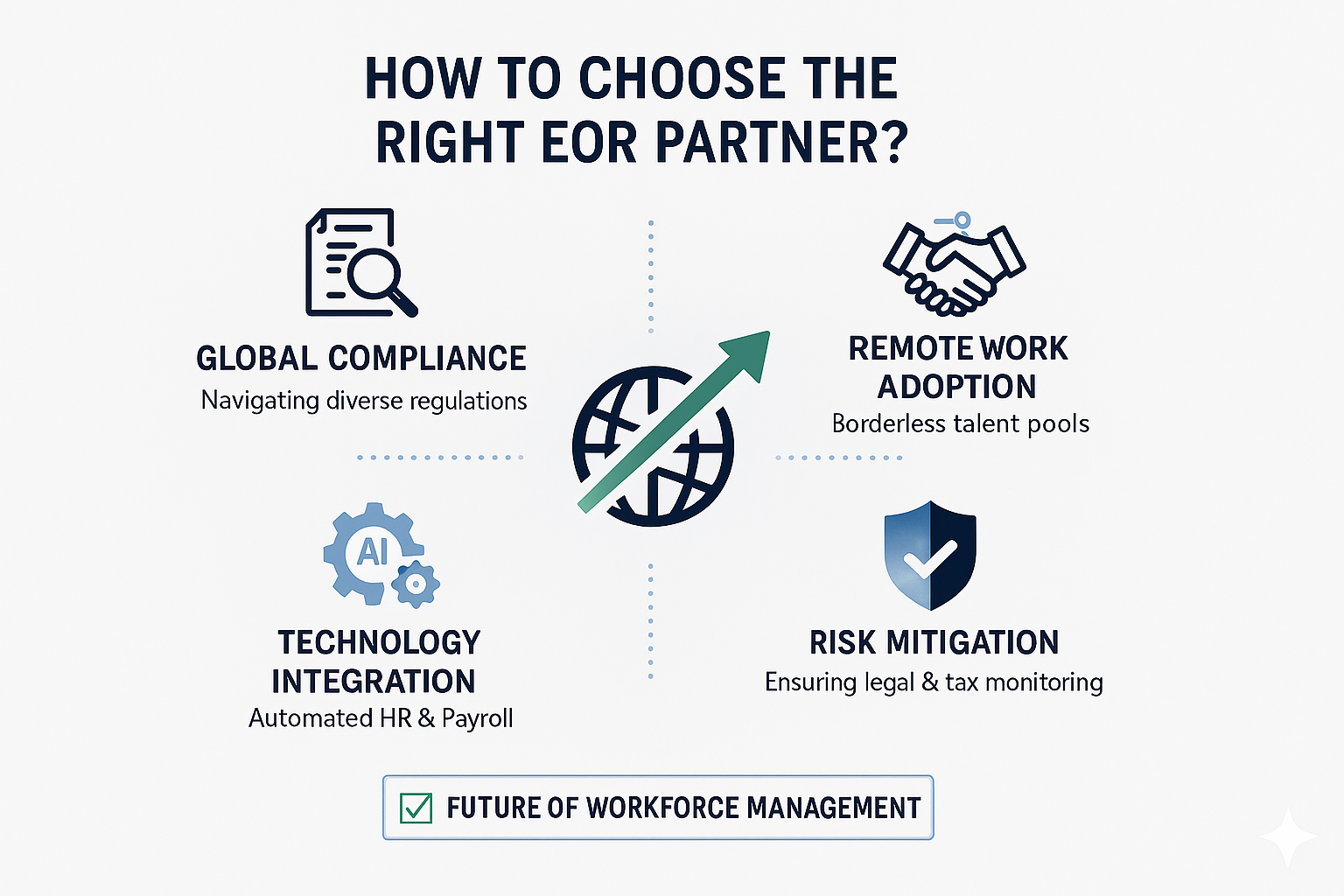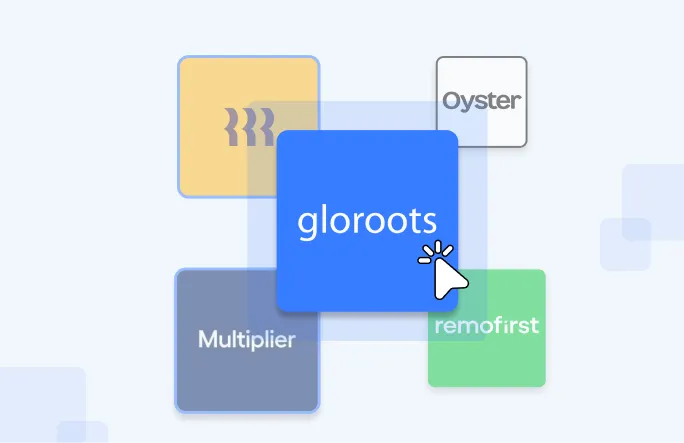Global hiring no longer requires setting up legal entities in every country you want to hire from.
The Employer of Record industry reached $4.71 billion in 2025, driven by companies treating distributed workforces as permanent infrastructure. Geopolitical instability, aggressive worker reclassification enforcement, and AI-powered compliance automation pushed this growth beyond anyone's expectations.

Here's the truth most vendors skip: outsourcing employment doesn't transfer your accountability.
This guide examines which EOR trends actually matter in 2025 and how they affect your global hiring strategy.
What’s Really Happening in the EOR Market Today?
- The EOR market is set to hit $7.8 billion by 2033, driven by small and mid-sized businesses seeking enterprise-level compliance at affordable costs.
- Asia-Pacific leads this growth, with India’s GCCs expanding fast and regions like Southeast Asia and LATAM attracting remote-first companies.
Evolution of the Role Played by EOR over the Years
- Five years ago, EORs were tactical Band-Aids while legal entities formed.
- HR leaders stopped asking "When do we transition off?" and started asking "Why establish entities everywhere?"
- Hybrid approaches work better for most organizations. Direct entities in core markets provide cost optimization while EOR flexibility elsewhere reduces risk exposure.
What Top-Tier EORs Actually Deliver?
An Employer of Record becomes the legal employer, assuming liability for contracts, payroll, benefits, and statutory filings across jurisdictions. But today's expectations extend far beyond compliant payroll processing.
HR leaders demand four things:
- Audit-ready reporting without manual reconciliation
- Transparent pricing without surprise fees appearing months later
- Proactive regulatory updates before laws change
- Employee experiences matching what entity-hired staff receive
Entity vs EOR Model: What Global Employment Trends Reveal
How EORs are Evolving Into Workforce Strategists?
The philosophical shift matters more than any technology upgrade. Leading providers stopped selling "compliant hiring." They now sell workforce strategy.
What does that include?
- Compensation benchmarking against local and global competitors
- Retention analytics reveal why employees leave before they do
- Learning pathways that work across borders and time zones
- Career progression frameworks for distributed teams
Gloroots demonstrates this evolution through India-focused GCC enablement.
Companies don't just hire in Bangalore. They build sustainable capability centers using talent advisory, onboarding playbooks, and benefits structuring that keeps retention high beyond year one.
Why Employee Experience Matters in EOR Success ?
- Employees hired through an Employer of Record often feel left out of the company culture. They receive offer letters from unfamiliar entities, get fewer benefits than in-house teams, and experience an onboarding process that feels impersonal.
- A good EOR changes that by offering local benefits on par with headquarters, customizing onboarding with your branding, and ensuring every remote hire feels included and valued.
- Losing engaged employees costs more than compliance issues. If your EOR hires leave quickly, your setup may be legally sound, but failing to build real connection and loyalty.
Key Technological Trends Transforming EOR Services
From AI-driven insights to seamless integrations, these innovations make hiring and compliance faster, smarter, and more transparent.
1. AI Improves Efficiency, Not Strategy
AI helps EORs detect payroll errors, contract issues, and regulatory changes quickly. But it can’t make complex decisions like handling misclassification risks or understanding local market sensitivities that still need human expertise.
2. Blockchain Brings True Transparency
Blockchain creates secure, tamper-proof payroll and contract records, making audits and compliance easier. It also speeds up background and credential verification, which is especially useful for regulated sectors like healthcare and finance.
3. Data and Integrations Drive Smarter Decisions
Predictive analytics identify the best global talent markets (like India, Brazil, Spain, and Singapore) and track workforce costs. Integrated systems like Gloroots connect with HR and accounting tools, giving CFOs real-time insights and eliminating data silos.
How Borderless Hiring Is Redefining Global Talent Strategy?
Global hiring today is all about finding the best talent, not the closest office. Companies now hire skilled professionals from anywhere, like engineers in Bangalore, designers in Buenos Aires, or support teams in Lisbon.
Employer of Record (EOR) platforms make this easy by removing the need for local entities, allowing businesses to hire in new countries within days instead of months.
4. Flexibility Creates Strategic Freedom
- Flexibility today means more than just remote work. It’s about scaling teams, exploring new markets, and adjusting hiring quickly without the hassle of setting up or shutting down entities.
- But switching EOR providers isn’t as easy as it seems — it can cause payroll issues, compliance risks, and benefit gaps. To avoid these problems, research your EOR thoroughly and understand how they operate before signing up.
5. Remote-First Economies Are Growing by Design
- Countries are introducing policies like Portugal’s digital nomad visa, Estonia’s e-Residency, and the UAE’s remote work visa to attract global talent.
- India remains a key hub for Global Capability Centers (GCCs), with strong hiring in Bangalore, Hyderabad, and Pune. As these markets grow, EORs must go beyond compliance and provide local expertise to help companies adapt to regional laws and culture.
Evolving Trends in EOR Market Growth and Global Adoption
6. Asia-Pacific, LATAM, and MEA Lead Adoption
- Regions with strong talent, lower costs, and clear remote work regulations are driving the fastest EOR growth.
- India leads this trend, with companies expanding GCCs for tech talent. Gloroots supports this by managing local compliance and helping businesses shift from short-term EOR setups to long-term entities.
7. SMBs Drive Fastest Segment Growth
- Small and mid-sized businesses are the fastest adopters of EOR services because they face higher risks from compliance mistakes and lack in-house legal teams to manage global regulations.
- Gloroots helps these companies hire quickly and safely by offering enterprise-level compliance support at affordable prices, allowing SMBs to compete globally with larger enterprises.
8. Vertical Expertise Matters More Than Breadth
- Technology and SaaS companies lead EOR adoption, while healthcare, finance, and manufacturing are quickly catching up, each needing industry-specific expertise rather than one-size-fits-all solutions.
- Healthcare firms need support with patient data and compliance, fintechs need help with financial regulations, and manufacturers require local HR and safety compliance — showing a clear shift toward specialized EOR services.
How to Choose the Right EOR Partner in 2025?
Choosing an EOR isn’t just about who offers the most countries or the cheapest plans. It’s about finding a partner that fits your operations, ensures strong compliance, and supports your long-term growth goals.

- Does the Provider Own Local Entities?
- Direct ownership ensures faster issue resolution, accountability, and a deeper understanding of local laws.
- Ask if the provider has local legal counsel, updates contracts quickly when laws change, and has a strong audit record.
- Are Costs Transparent or Full of Surprises?
- Watch for hidden costs like FX markups, benefits add-ons, or offboarding fees. Gloroots offers transparent, line-item invoicing with clear GL mapping.
- Review contracts for pricing changes or penalties. Flexible monthly terms often suit growing companies better than long commitments.
- Do Integrations Actually Work?
- Real integrations sync data directly with your HR and accounting tools, not just CSV exports.
- Always test integrations in your system to confirm they work as promised before signing up.
- What's the Employee Experience Really Like?
- Ensure EOR employees get competitive benefits, quick support, and a smooth onboarding experience.
- Poor employee experience leads to turnover. Ask for feedback from employees managed under the EOR, not just HR teams.
Gloroots' complete EOR selection framework with evaluation scorecards, vendor comparison templates, and contract negotiation guidance.
What's the Future for EOR Services?
Three dynamics define where the industry heads over the next several years:
- AI Handles Execution, Humans Handle Judgment
AI now automates payroll, compliance checks, and reporting with high accuracy. But decisions like where to hire or when to move from EOR to a full entity still need human judgment and business context.
- Hybrid Models Are the New Normal
Companies are blending EOR and direct entity models — using EORs for quick market entry and entities for core regions. This balanced approach supports flexibility, cost control, and long-term planning.
- Compliance Responsibility Still Lies with You
Even with automation, legal accountability remains with the employer. Regulators won’t accept “our EOR said so.” The best EOR partnerships are built on transparency, shared responsibility, and proactive compliance management.
The future of work is undeniably global. Companies embracing this reality and partnering with the right EOR don't just achieve compliance.
They gain strategic advantages through faster hiring, access to broader talent pools, and operational flexibility that competitors lacking global infrastructure simply cannot match.
FAQs on EOR Trends
1. What is an Employer of Record and how does it work?
An Employer of Record (EOR) legally employs workers on your behalf in other countries. It manages payroll, benefits, and compliance while you retain full control over their daily tasks and performance.
2. How is AI transforming EOR services in 2025?
AI helps automate payroll, compliance checks, and legal updates across regions. However, human oversight remains essential for judgment-based decisions like worker classification and cultural or legal nuances.
3. What are the biggest risks companies face when using an EOR?
Key risks include worker misclassification, hidden fees, and compliance issues. Poor employee experiences or communication gaps with the EOR can also lead to retention and operational problems.
4. When should a company transition from EOR to a local entity?
When a company hires 15–20 or more employees in one country or plans long-term expansion there, setting up a local entity becomes more cost-effective. Many firms use hybrid models—EOR for new markets and entities for core ones.
5. How do I choose the right EOR provider for my business?
Choose a provider with strong compliance systems, transparent pricing, and reliable integrations. Local expertise, responsive support, and a great employee experience matter more than just a large country list.

.webp)




























.webp)























.webp)


.webp)


.webp)






